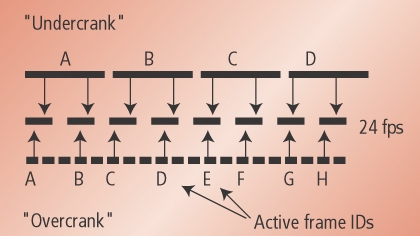Panasonic’s variable-frame-rate camcorder

In the early days of moviemaking, before the advent of “the talkies,” there was no standard frame rate for capturing images on film. Cameras were hand cranked, and cameramen needed a steady, experienced hand to crank the film through the camera at a constant speed.
To record sound on film properly, film had to be cranked at a constant speed, and it had to be faster than 16 frames per second. Stanley Watkins, a British engineer working for Western Electric, decided that 24 fps would do the trick. Thus, since the advent of talking pictures in the 1920s, cinematographers have captured images on film and played them back at a standard frame rate of 24 fps.
One new professional camcorder capable of multiple-frame-rate videography is the Panasonic DVCPRO AJ-HDC27V. The camera portion of this high-definition camcorder employs a simple technique for overcrank and undercrank shooting. It is important to note that only the camera portion of the camcorder operates at multiple frame rates. The recorder portion of the camcorder operates as a standard 720p, high-definition VTR, recording images at 60 fps.
Figure 1. The results of overcranking or undercranking video at a display rate of 24 frames are shown above.
How it works
The camera portion of this camcorder can be set to any one of 33 frame rates: 4 fps to 33 fps in single-step increments, and 36, 40 or 60 fps. When set at 60 fps with no shutter setting, the camera’s exposure time is automatically set to 1/60th of a second and each frame is recorded once by the recorder section of the camcorder. The image motion blur is controlled by combining the variable frame rate with the variable shutter speed. Combining the two controls gives cinematographers film-like control of the HD video. Whenever the camera’s frame rate is set lower than 60 fps, exposure time increases proportionally and redundant frames are recorded onto tape. These redundant frames are used to maintain a constant flow of exactly 60 fps to the recorder section.
When used in, say, a 24 fps environment, the camcorder can be set to a higher frame rate to achieve slow-motion effects, or it can be set to a lower frame rate for fast-motion and time-lapse effects.
The professional video industry's #1 source for news, trends and product and tech information. Sign up below.
Predicting and reproducing frames
The camcorder marks each image with a time code user bit. Each time a new video frame is acquired by the camera, it is marked as an “active frame.” If a frame is recorded more than once just for the sake of the recording process, it is marked as an inactive frame that can be dropped, if necessary, when editing or converting it to a different DTV format.
Panasonic has demonstrated a processor that automatically extracts the active frames and drops the inactive frames. The processor ingests 720p60 video with user bits over a standard HD-SDI input. The images are stored on disc in their original compressed state exactly as recorded in the camcorder. The output video can also be transferred over SDTI or SDI if desired.
Only active video frames are stored on disc, thereby reducing the cost of storing high-definition footage on the processor’s hard discs. The processor records each marked active frame in an AVI file on the internal hard discs. After the video file is built, it reads out at the desired frame rate by re-inserting the appropriate number of inactive frames.
David Wiswell is group manager for Panasonic Broadcast and Television Systems Company.
